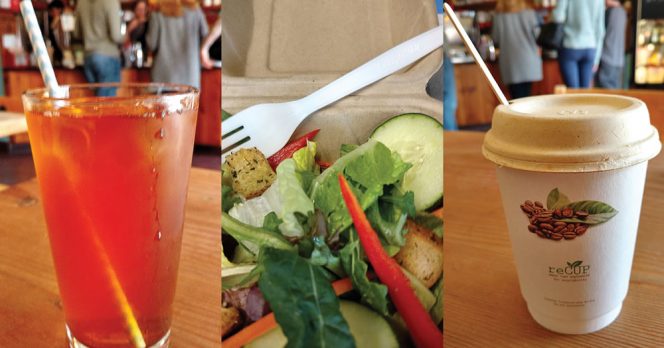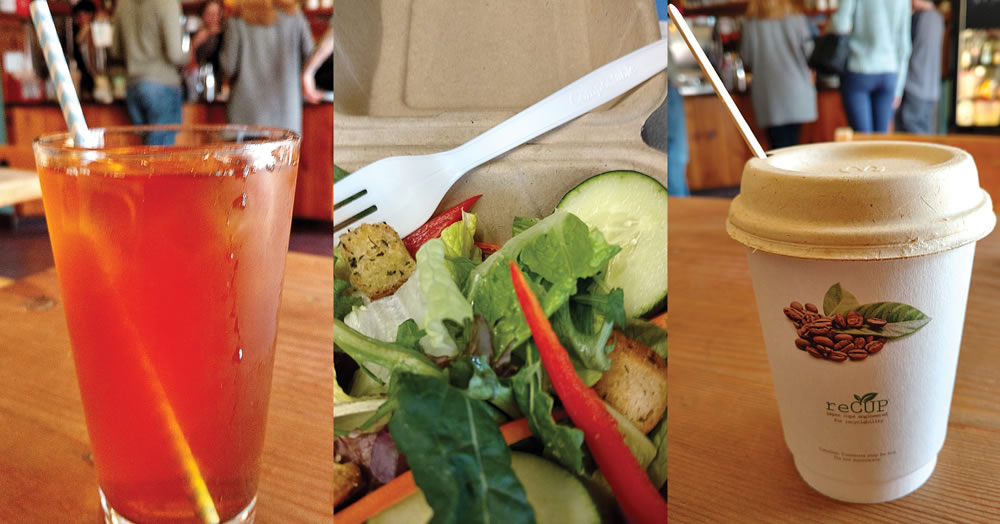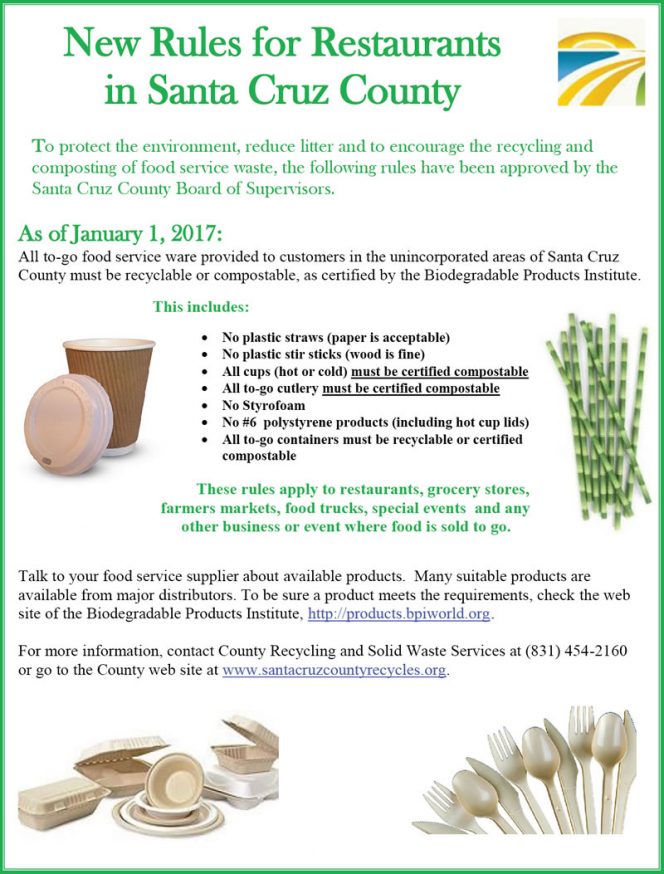All to-go food serviceware must be compostable or recyclable in the unincorporated areas of Santa Cruz County.
Tim Goncharoff
BioCycle May 2017

Paper straws eplaced plastic (left). Clamshells and cutlery must be certified compostable (middle). Plastic stir sticks, polystyrene lids and plastic-coated cups are prohibited (right).
Early in the morning, the chefs at Dominican Hospital in Santa Cruz harvest what’s ripe in their organic garden. Fresh greens for salads, herbs for seasoning, potatoes and squash for soup, flowers for the tables. In the cafeteria, bins for food scraps sit next to those for trash and recycling, and everyone knows what goes where.
At Café Cruz in Soquel, a busy high-end restaurant, chef and owner Steve Wilson keeps one eye on the managed chaos of the kitchen and another on the rapidly filling dining room. Wilson is devoted to turning out excellent food, outstanding service and as sustainable a dining experience as possible.
Three times a week a packer truck rumbles through the streets of Santa Cruz County, California, stopping at these and more than 50 other locations. Restaurants, grocery stores, hotels and schools all contribute kitchen scraps, soiled paper and the remains of meals to the mix. At the end of the route, the truck drives about 40 miles to the Monterey Regional Waste Management District’s dry fermentation digester in Marina (Monterey County), which processes the organics to extract energy, feeding it into the local grid. A few weeks later the digestate is removed from the fermenter and composted with yard trimmings in a nearby windrow. After a few more weeks of decomposition, the compost is sold to local farmers, gardeners, vintners and landscapers.
Santa Cruz County was an early adopter of commercial food waste collection, beginning its program in 2006. More than 100 sites now participate, ranging from big resorts and the county’s two hospitals to supermarkets, restaurants and coffee shops. In 2016, more than 1,000 tons of food waste were collected. The program is a success by any measure. But now the State of California has upped the ante.
As part of its battle against climate change, California passed AB 1826 in 2014, which requires all large generators of organic waste (primarily food scraps and green waste) to separate it from their trash for diversion. The requirements are phased in over a few years, eventually pulling in almost all businesses producing any significant amount of organic waste. The effective date for generators producing greater than 8 cubic yards/week of yard trimmings and food waste was April 1, 2016. Of the current 100-plus generators on the program, about half had to comply with AB 1826 by that date; the other half participate voluntarily.
In 2016, the state took another significant step with the passage of SB 1383, requiring a 75 percent reduction in statewide disposal of organic waste by 2025. Communities around California are scrambling to set up programs like the one in Santa Cruz County.
New Rules For Restaurants
Santa Cruz County’s 10 years of experience with commercial food waste has clued it in to some of the program challenges. Frequently, restaurants’ organics bins contain paper cups, plastic straws, forks, spoons, lids and all the other flotsam that goes with eating on the go. The recycling bins also have the same paper cups, plastic forks, plastic stir sticks and more. But how much of this is really recyclable? How much is compostable? And how can we tell?
Santa Cruz County made an attempt at addressing the problem with passage of an “Environmentally Sustainable Packaging Ordinance,” enacted in 2008. This law specifically banned the use of polystyrene foam in food service, and further required that “all to-go food serviceware shall be compostable or recyclable.” The ordinance was a great success, as far as it went. While it includes provisions for fines, nothing more than a little arm-twisting was required, and this only rarely. Polystyrene foam all but disappeared.
But what exactly “compostable or recyclable” meant in 2008 wasn’t all that clear. These were the days when some “biodegradable” spoons were melting in customers’ soup, while others were found to be made of petroleum-based plastics and were not biodegradable or compostable at all. What about a paper cup lined with PET? Recyclable, compostable or neither? And then there were all the products made of technically recyclable materials like polyethylene, but which were handicapped by their size, shape or weight.
BPI promotes the use and recycling of biodegradable materials via composting. Certified labs verify claims for compostability of food service products, and those that meet the standards are listed on BPI’s website, products.bpiworld.org. Products of all types from cups to bowls to cutlery, from many different manufacturers, are listed on the site, providing options for business owners and assurance for program operators reluctant to rely on manufacturers’ claims alone.
The list of problematic products is long and diverse. Aside from polystyrene foam, which is banned in almost all forms, some plastic products are challenging, not because of their composition, but due to their shape and size. Plastic straws and stir sticks tend to slip through the gaps in automated sorting machines, making them tough to recycle. Santa Cruz County bans those items, but allows paper straws and wooden stirrers, for example. Plastic-coated paper cups can be replaced by cups that are solid paper and thick enough to contain both hot and cold liquids while being fully compostable. Multiple bags, bowls, plates and clamshells made entirely of paper or plant fiber are now available.
After announcing the new rules last summer, Santa Cruz county officials conducted extensive outreach to local businesses. Since the official rollout on January 1, more than 200 food service businesses in Santa Cruz County have made the switch. Ranging from small coffee shops to giant resorts, all have had to source new supplies in the last several months, but the process has gone smoothly. Area food service suppliers were brought into the circle early in the process, to allow them time to stock up and inform their customers. As is often the case, local managers of chain outlets from Starbucks to Jack-in-the-Box, referred county staff to corporate offices in distant cities, where reactions ranged from “You’re doing what now?” to “You guys again, huh?”
But everyone has successfully made the transition, and some see this as a helpful kickstart to a more sustainable direction they planned to pursue anyway. Sara Tikilis, manager of a local coffee shop, said: “We always try to be as green as we can. We really only had to change a few products. It was easy, and our customers love it!”
Tim Goncharoff is an environmental planner in Santa Cruz County, California.











